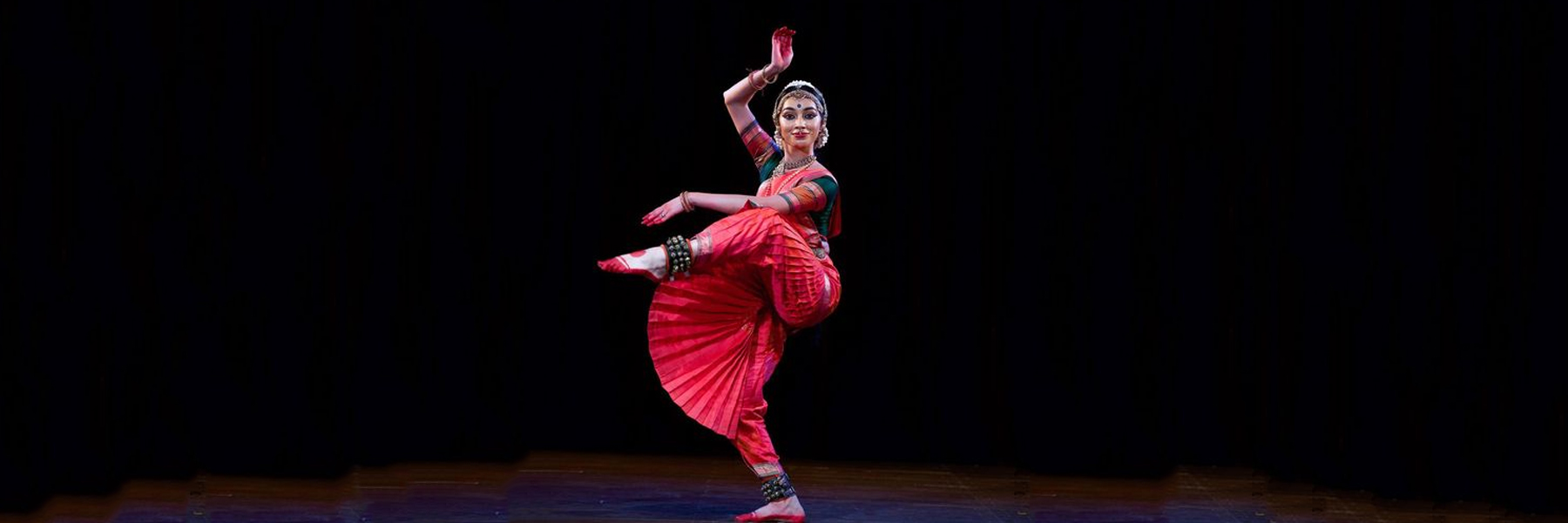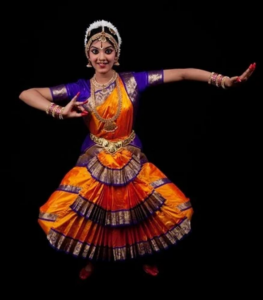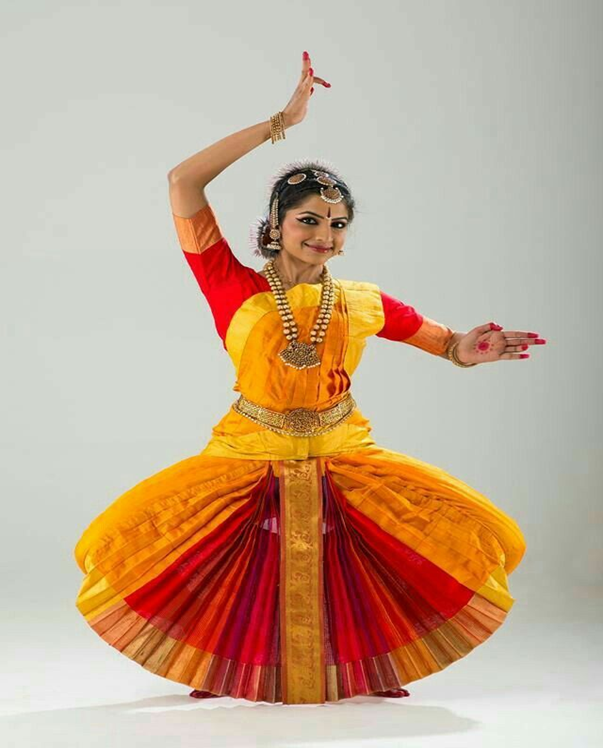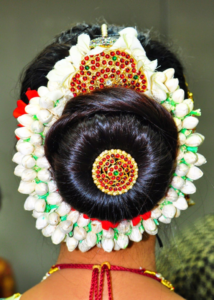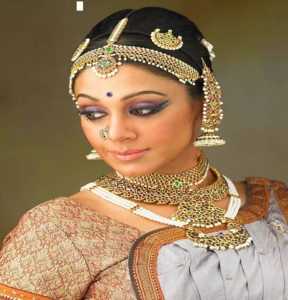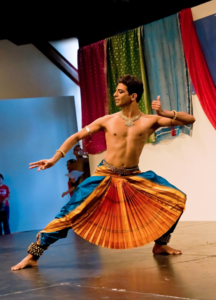Bharatanatyam is one of the oldest classical dance styles in India. It originated in Tamil Nadu from the ritualistic song and dance recitals performed in the temples of ancient India for centuries. Roots of Bharatanatyam can be found in the ancient Devadasi tradition, where a devadasi performed song and dance as part of her ritual offerings to God. Rhythmic movements, vivid expressions, and indicative gestures are principal characteristics of Bharatanatyam.
In history, dancers performed in temple settings with simple designs and minimal ornaments. As Bharatanatyam transitioned from temple rituals to stage performances, the costumes evolved to become more colourful, elaborate, and grand, with the introduction of stitched, embroidered costumes. Bright colours with silk fabrics paired with temple jewellery made of gold and featuring intricate designs were formulated. Decorative makeup and ghungroo’s were a part of this modern Bharatanatyam costume.
b) The Pre-stiched Saree for Bharatanatyam
A modern Bharatanatyam dress consists of a pre-stiched saree or a readymade Bharatanatyam costume for convenient dressing.
A typical Bharatanatyam costume for women consists of a silk saree with embroidered edges, divided into distinct parts that are stitched independently. These different parts, when worn together, form the entire Bharatanatyam dress. In a modern Bharatanatyam dress, a pant-like structure called a ‘dhoti’ is premade, which can be worn like a ‘salwar’, which in turn reduces the amount of time taken to dress up.
A corresponding blouse, which is tight fitting and in a contrasting color, is worn with this ready-made type of Bharatanatyam costume. The saree’s pallu covers the chest and is draped over the left shoulder, tied tightly across the waist.
A wide flare fan, similar to the pleats of a traditional saree, is tied/sewn to the salwar such that it is placed at the center of the dancer’s body. The pleats of this fan flare out when the dancer is in the ‘Aramandi’.
The fourth part of the readymade costume is draped around the posterior of the dancer and is secured to the waist of the dancer before covering it with the fan. A small fan is then attached to this part, which, when fastened at the back, is positioned exactly about the large fan.
The jewelry used for Bharatanatyam is intricately designed in traditional patterns, adorned primarily by female dancers. A circular piece of jewelry won over a tightly secured bun at the back of the head is a headgear called the ‘Rakodi’. A ‘Gajra’ (wreath of white or orange flowers) is worn around the bun on the head.
-A tika or bindi worn on the head of the dancer has three parts, with the circular bindi attached to the central part, which hangs over the dancer’s forehead. This is called the ‘Talaisamana’.
The Chandra-Surya, copies of the sun and the moon are worn on either side of the head. They are made of sparkling stones and pearls, which cover the head of the dancer, worn one each on either side of the central bindi.
Several necklaces—a small one called the ‘Attikai’ and a long, intricately designed ‘Muttumalai’ made of stones and pearls—are worn as central pendants. Another addition to this is the occasional use of ‘Kashumalai’, made of small golden overlapping circular parts, also called ‘Kashimala’.
The nose is adorned with a small nose ring studded with stones, called ‘Nattu’ and a ‘Bullakku’, a nose ornament worn between the nostrils. Earrings (‘Jimikka’) and bangles (‘Valaila’) are used to adorn the dancer.
A golden belt known as ‘Odiyanam’ or ‘Ottiyanam’ worn around the waist helps secure the drape of the dancer’s ‘pallu’ and improve the dancer’s posture.
‘Alta’ or ‘Marutani’ is a red dye, or henna, applied to the hands and feet of the dancer to emphasize their mudras and steps. A sacred red dot, or ‘Kumkuma’, applied on the forehead is known as ‘Vasukutti’.
5) The Male Bharatanatyam Costume
The Bharatanatyam costume for men is relatively simpler as compared to that of the female dancers; with the lower body covered in a pleated dhoti or ‘pitambara’, the dancers and their steps are enhanced by these flared-out fans. The upper body of a male dancer is bare, often adorned with minimal jewelry, such as a central long pendant or the sacred thread. Often, male dancers drape an ‘uparna’ or ‘uttariya’ over their shoulders.
Comfort and flexibility are crucial while making fabric choices for Bharatnatyam costumes, as the dance form involves an array of moments that are physically demanding.
Breathability: Bharatanatyam includes complex adavus, intricate footwork, and expressive poses. Hence, the breathability of the fabric, particularly during long performances, must be ensured through the use of lighter fabrics, which prevent overheating and provide comfort.
Durability:Bharatanatyam involves vigorous footwork and frequent hand movements; hence, the fabrics need to be strong enough to endure such constant wear and tear.
Lighter and modern fabrics that have breathable and lighter blends that can depict traditional looks without wearing the dancer down are to be selected.
Color Symbolism
: In Bharatanatyam, the colours of the costume are not just chosen for aesthetic appeal but hold deep symbolic meanings, reflecting the theme of the performance and cultural significance. Bharatanatyam offers a wide range of emotions and themes, from devotion, love, valor to sorrow. The colours in the dancer’s costume can be carefully chosen to amplify such emotions and to manifold the narrative and overall impact on the audience, such as the use of the color red to indicate tradition, passion, energy, strength, and love.
Contemporary Trends:
Traditional Bharatanatyam costumes remain rooted in the rich history and symbolism, yet there have been many adaptations to form the modern Bharatanatyam costume. Designers have found innovative ways to blend tradition with modern styles and comfort and have incorporated fresh elements into the attire.
Simplification of the design with lighter fabrics; simpler designs have been introduced, which offer free movement and comfort. Such costumes have subtle embroidery and digital prints instead of heavy work, reducing the weight.
The use of lighter fabrics with silk blends or chiffon, which are easier to manage and less restrictive, is incorporated. They maintain the flow and grace of the costume while providing room for modern ideas. Several fusion costumes that feature Western elements, such as jackets, have been integratedto make modern Bharatanatyam costumes.
Care and Maintenance:Caring for Bharatanatyam costumes is essential to ensure their longevity and maintain their beauty over time, especially since they are made from delicate materials like silk and have intricate embroidery.
- a) Dry cleaning of costumes made of silk or other fabrics with heavy embroidery is to be ensured to avoid damage.
- b) Hand washing of simpler fabrics, such as cotton or light work fabrics, with special attention to use of mld detergent and cold water.
- c) Proper storage of the costume in cold, dry areas with separate storage of all the different pieces to avoid tangling or damage to embellishments.
- d) Using cotton or other breathable garment bags instead of plastic to store the costumes.
In conclusion, the different types of Bharatanatyam costumes are not just visually appealing but are also a vital part of the art of expression. Each style, from the flared fan to the ‘alta on the hands, the bindi on the forehead to the ghungroo on the feet, enhances the grace, expression, and cultural depth of a performance. A Bharatanatyam costume is art, a celebration of traditions and years of development.Step into the world of Bharatanatyam costumes, where each fabric tells a story of tradition, grace and craftsmanship. If you are a dancer or an enthusiast, we can help you with a world-class Bharatanatyam expert to explore the rich heritage of Bharatanatyam dance and its costumes!
